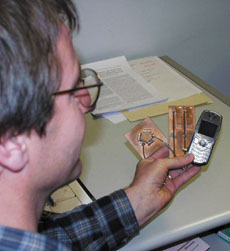|
|
.gif)
With today’s
accelerating popularity of wireless communications, one busy area
of research in Hong Kong is smart antennas.
 At
The Hong Kong University of Science & Technology (HKUST), two research
projects are looking at how to optimise performance of multiple-input
multiple-output (MIMO) technology which promises big increases in
performance without the need for more radio spectrum or power. At
The Hong Kong University of Science & Technology (HKUST), two research
projects are looking at how to optimise performance of multiple-input
multiple-output (MIMO) technology which promises big increases in
performance without the need for more radio spectrum or power.
 |
| Prof
Murch with a prototype of the compact two antennas in one design |
While
one project has computed how to reduce signal interference (seeAlgorithm
leads to boost in performance), the other has devised a compact
MIMO antenna by combining two antennas into one.
 Principal
Investigator of the antenna design project, Prof Ross Murch, explained
that using multiple antennas increases the number of transmitting
channels and therefore allows greater speeds of data. Principal
Investigator of the antenna design project, Prof Ross Murch, explained
that using multiple antennas increases the number of transmitting
channels and therefore allows greater speeds of data.
 “In
radio communications, there are two key items: bandwidth and power.
With the MIMO antennas you don’t need any more bandwidth or power
so it seems you get something for nothing.” “In
radio communications, there are two key items: bandwidth and power.
With the MIMO antennas you don’t need any more bandwidth or power
so it seems you get something for nothing.”
 He
added: “That’s
good news for mobile phone operators who get a limited spectrum from
the government. With multiple antennas and the same spectrum, they
can send more data which means more users or getting people to use
additional services like video-telephones.” He
added: “That’s
good news for mobile phone operators who get a limited spectrum from
the government. With multiple antennas and the same spectrum, they
can send more data which means more users or getting people to use
additional services like video-telephones.”
 Multiple
antennas, however, need to be spaced apart so they do not interfere
with each other. Traditional thinking says they should be spaced apart
by half the wavelength they are being used for. For a mobile phone
using a frequency of 900 Mhz, two antennas would need to be 15cm apart. Multiple
antennas, however, need to be spaced apart so they do not interfere
with each other. Traditional thinking says they should be spaced apart
by half the wavelength they are being used for. For a mobile phone
using a frequency of 900 Mhz, two antennas would need to be 15cm apart.
 Said
Prof Murch: “This
means that multiple antennas are quite impractical for compact devices.
As antenna designers, we needed to ask if we can do anything clever
to make the design smaller.” Said
Prof Murch: “This
means that multiple antennas are quite impractical for compact devices.
As antenna designers, we needed to ask if we can do anything clever
to make the design smaller.”
 His
research came up with an answer. As radio waves come in different
orientations, he used a polarisation technique of placing two antennas
perpendicular to each other. They then became “fairly
independent”
and interference dropped off significantly. His
research came up with an answer. As radio waves come in different
orientations, he used a polarisation technique of placing two antennas
perpendicular to each other. They then became “fairly
independent”
and interference dropped off significantly.
 He
combined this with two “diversity”
ideas which increase the likelihood of catching good signals and came
up with the compact design. Prof Murch’s research also looked
at the safety aspect of using a mobile phone with a design of the
MIMO antenna and found that electro-magnetic radiation was reduced
by 25 to 50 per cent. He
combined this with two “diversity”
ideas which increase the likelihood of catching good signals and came
up with the compact design. Prof Murch’s research also looked
at the safety aspect of using a mobile phone with a design of the
MIMO antenna and found that electro-magnetic radiation was reduced
by 25 to 50 per cent.
 “Although
radiation from a mobile phone has never been scientifically proved
to be harmful to health, it’s
good to be able to control it,” said Prof Murch. “Although
radiation from a mobile phone has never been scientifically proved
to be harmful to health, it’s
good to be able to control it,” said Prof Murch.
Principal
Investigator
Prof Ross Murch : eermurch@ee.ust.hk

|

